


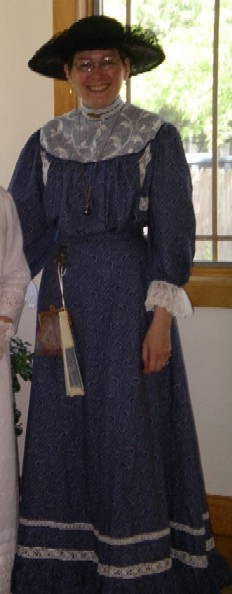
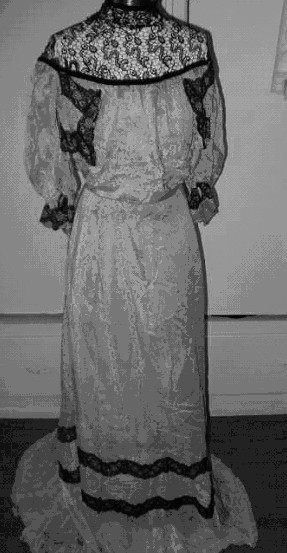
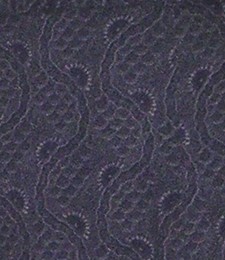
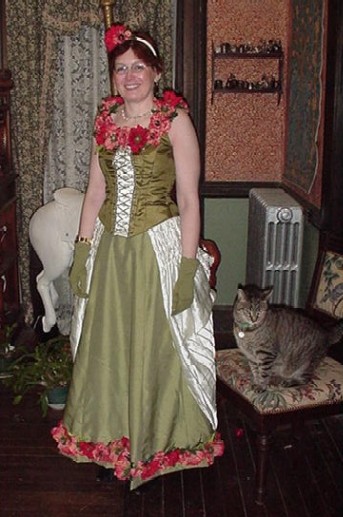

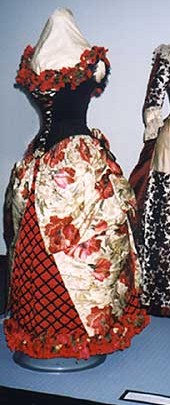
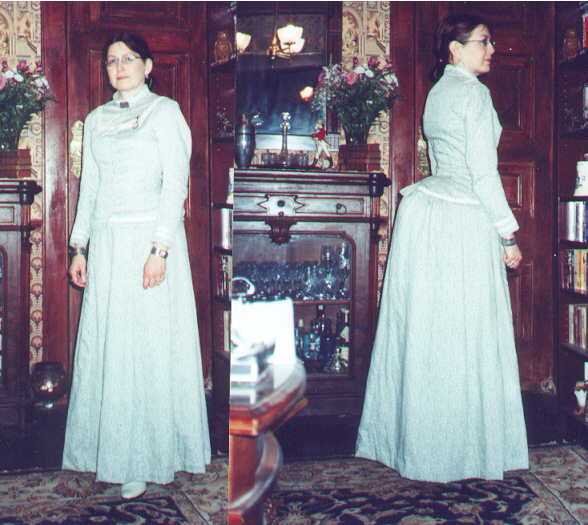
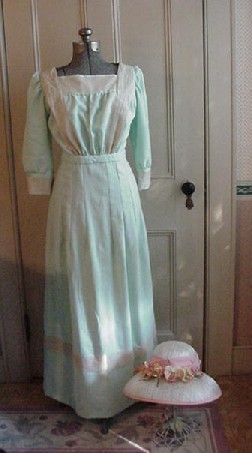



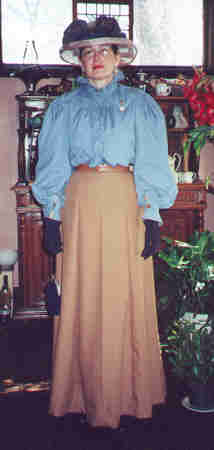
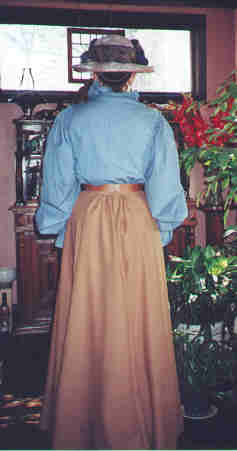
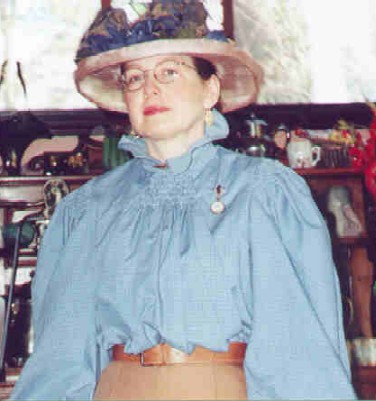

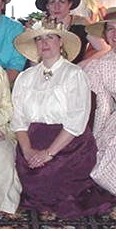
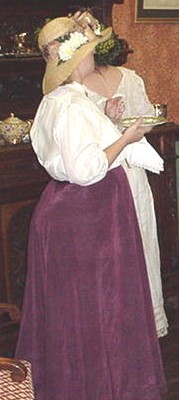



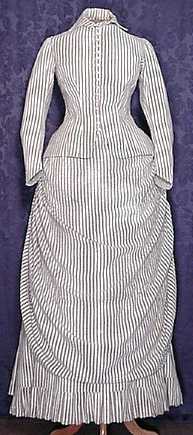
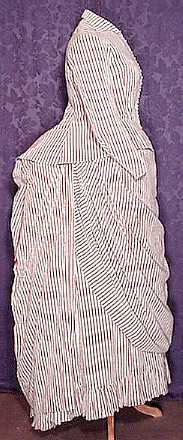
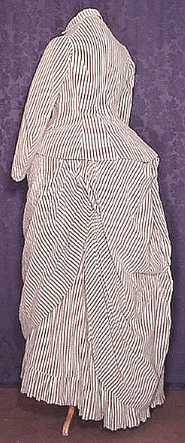
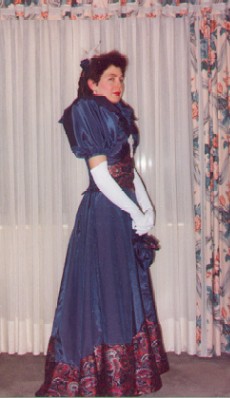
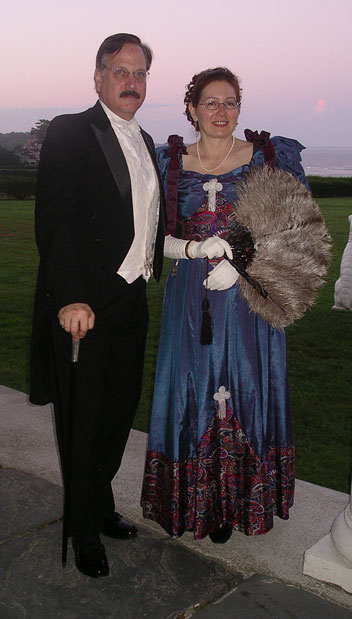


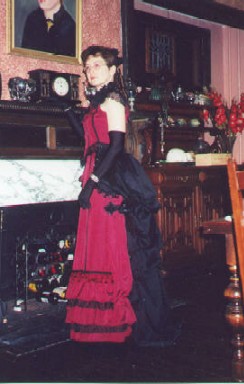
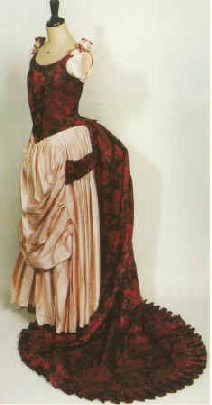 Surprisingly, I recently came across this replica dress from the Artefact (sic) Collection belonging to the East Dunbartonshire (UK) Council's education system. This strongly resembles my dress, particularly in its original state!
Surprisingly, I recently came across this replica dress from the Artefact (sic) Collection belonging to the East Dunbartonshire (UK) Council's education system. This strongly resembles my dress, particularly in its original state!
| My latest projects (as of May 2004) | |
   | On the left, a gown for a 1904 St. Louis World's Fair ball. This turned out to be actually more of an afternoon dress (and not elaborately trimmed enough for the period, at that) but I thoought I'd get more use out of it this way. At least I could wear it to tea, for example. The pattern is custom drafted from The Edwardian Modiste and is from 1907. The top is a pale yellow cotton with a woven-in stripe and a pattern of tiny purple and green rosebuds and black pin dots. The skirt is a purple handkerchief-weight linen. The belt is dark green velvet shirred onto a backing of chair webbing. The antique lace is something called "Indian Crash." The bodice fabric was 32" wide and part of an inherited fabric stash; the skirt material was the end of a bolt. Consequently, I barely had enough for the dress, and had to cut both parts cross-grain. Ideally, the skirt should have originally been longer, but needed to be this short to allow me to dance safely. On the right (showing front and back), you see I've added embellishments based on a period original to make it a true afternoon dress, and let down the hem, too. Personally, I still don't think this Edwardian look is a good one for me or for most people. Too much dress. |
   | This two-piece day dress is based on one being sold on eBay. The original was a pink cotton print with black lace (I couldn't get the photo to copy in color for some reason, and the fabric is not at all shiny like this image makes it appear to be). When I saw the original, I realized it looked just like the Folkwear Gibson Girl blouse and a walking skirt, so I set out to replicate it, using a nice 1890s-looking blue calico I'd found at WalMart for $2.49/yard. The design seemed to have an early Art Nouveau feel to me. Most of the lace is antique, except for the yoke, which is modern curtain lace from Calico Corners. The most difficult part (besides the long ruffle at the bottom) was positioning and sewing the lace at the sides and under the sleeves, as the bodice is gathered there. I am very happy with this outfit, and it is comfortable to wear as well. |
   | This ballgown is based on a red and black c. 1883 ball gown by Mrs. Donovan of New York, now in the Vincent Collection. The bodice is the Truly Victorian 1885 Cuirass Bodice, cut along the ballgown version lines. An insert of the overskirt fabric creates a placket for the buttons, and lacing, purely ornamental, goes over that. The striped overskirt is more or less the bottom half of the Truly Victorian 1873 Polonaise, shirred and gathered onto a separate waistband. The underskirt is the Old World Enterprises 1880s bustle gown skirt. All the silk poppies are sewn onto a separate fabric strip that's whipstitched onto the bodice and hem to make the gown more easily cleanable (washable, actually). Kermit (on the chair) is helping me model it, since he oversaw so much of its construction. |
| This is the Sense and Sensibility Beatrix jacket in a heavy houndstooth denim-y sort of fabric ($2/yard, Wal-Mart) and a black corduroy collar. It's actually a nice crisp design, not all moire-y like the photo appears. The jacket is fully lined using modern lining techniques. I will eventually be adding slash pockets; I ran out of time but the instructions appear to be very complete. The jacket back features two deep pleats. The skirt is another copy of the Old World Enterprises Gibson Girl skirt, with a pair of box pleats at the back waist, to echo those in the jacket, instead of the gathers called for by the pattern. The hat is a recycled wide-brimmed wool hat from the 1970s with relocated ostrich feathers and a large houndstooth ribbon bow on the front. I found I had to cut this jacket pattern a size and a half up from my regular size. Once I worked that out, the construction was simple and I am very pleased with the outcome. | |
| The bodice is from the Fashion Historian Simplicity 5724 ballgown; the box-pleated skirt is a copy of one in the Morris County Historical Society collection. Made up in a bright salmon moire (deeply discounted on Philadelphia's Fabric Row) with a ribbed cream bertha and cream grosgrain ribbon trim on the skirt. The bodice pattern is very easy to work with, and the design of the sleeves -- a sleeve within a sleeve -- ensures a nice puffy shape. I redesigned the back so that it closes with a row of small shell buttons, rather than lacing up the back. As I am hair-challenged, I made a simple headpiece on a headband with silk leaves and berries matching those on the bertha. This withstands waltzing well. | |
| Sense and Sensibility's Regency gown, in a blue-on-yellow cotton calico print ($1/yard, Wal-Mart). This pattern made up quickly and the directions are straightforward (and the online assistance is valuable, too), but fitting this gave me fits! Evidently I am much longer from shoulder to bust than average; the underbust seam originally hit me across the points of my breast -- so of course it didn't come close to closing in the back. I had to add two inches to the bottom of each bodice piece, and widen the sleeves. Luckily, they're all simple shapes and this was not difficult (and I had enough fabric to redo the bodice). Once this was done, the underbust seam was exactly the right diameter for me without adding any width at all. I also found the sleeve bands aren't wide enough to easily put in buttonholes for attaching the removable long sleeves; I ended up slipstitching the sleeves in and will remove them when I need to wear the gown in warmer weather. The bonnet is an original design by a very talented friend of mine, Shenlei Winkler. | Truly Victorian's TV410 1873 Polonaise. This pattern offers the same semi-customized sizing as my favorite TV460 Cuirass Bodice, so I took a chance that if I selected the same size pattern pieces as I use for the Cuirass, it would fit. Luckily, it worked. This went together incredibly fast and I love the way it turned out. As I did not have enough fabric to do the sleeves in a single color, I made the large pleated cuffs out of the underskirt material, which gives a pleasing contrast. The bodice edges and cuffs are trimmed with a blue-yellow-white twisted cording, and large yellow roses emphasize the bustle. The gathers in the bustled back are held in place with a series of sewn-in tapes; doing this on a dress form helps immeasurably. Note that this pattern contains only the jacket. The skirt is made from the Old World Enterprises ballgown (see below) pattern. |
| Previous projects | |
 | A very quickly made walking dress (made up in less than a week) from Truly Victorian's 1880s cuirass bodice pattern and the simple (as in style, not in construction -- the pattern has all the flaws of any OWE pattern) bustle skirt of Old World Enterprise's 1880s ballgown. A WalMart $1/yard calico and some nice vintage cotton lace in two sizes. |
 | Folkwear's #220 Garden Party Dress, made up in a washable faux linen and trimmed with vintage lace. This pattern was pretty straightforward and made up quickly once I figured out the slightly confusing explanation of how the bodice facing is attached. I love the look of the bretelles (shoulder straps) and have been dying to use that word in conversation ever since I learned what it meant. The waistline is just a little higher (about a half-inch) than my natural waistline; I've been assured by friends more knowledgeable in this period (19-teens) this is the style, rather than a pattern flaw. Flattering and easy to wear. |
 | A close-up of the 2.5" wide vintage cotton lace trimming the Garden Party Dress above. |
 | Two views of the winter walking suit from the same Truly Victorian patterns used for the teal striped walking dress below. I successfully shortened the bodice pattern a bit so the fit is better. The body is a heavy cotton moire jacquard; the trim a patterned cotton I've been saving for about 10 years in anticipation of making a suit just like this. The trimming uses authentic techniques picked up during my research of the Morris County Historical Society's wedding gown collection. |
 | A Civil War one-piece daydress based on the Past Patterns Garibaldi shirt (709) and drawing on originals in the Morris County Historical Society collection. The skirt is just three lengths of fabric cartridge-pleated onto the same waistband as the bodice. I put a pocket into one of the seams. This dress has a dogleg closing, meaning the buttons run down the center front, then the waistband continues to the side, where the skirt pieces overlap in an opening. This is a soft cotton plaid flannel from the $1 bin at Wal-Mart, and took less than a week to complete. (Why am I standing that way? I don't know.) |    |
| Past Patterns' Eritrea blouse, with cartridge pleating detail on the sleeves and neck. In spite of the kangaroo-pouch front, it's built on a form-fitting lining. I skipped the boning. It went together surprisingly easily, although I was making it in a size 12 from a used pattern already cut to a size 10. I did find that when the directions seemed illogical and I didn't follow them, I got into trouble and ended up ripping apart and redoing according to instructions. Here's one pattern you can trust! Shown with yet another Old World Enterprises Gibson Girl walking skirt, unfortunately in polyester. I've since replaced it with an identical one in linen. It's a good thing that pattern is on heavy paper or it would have self-destructed by now. | |
 | |
| This is the Past Patterns 1880s day dress, explained more fully on its own page. This pattern made up beautifully and fit with essentially no alterations, as easy as a pattern from one of the big commercial companies. I only wish it were a less historically idiosyncratic style! (See the "dress reform movement" information on my home page.) | |
    | |
| Three variations on the same theme, the Gibson Girl look. Both the purple and yellow skirts are the Old World Enterprises Gibson Girl skirt, their least irritating pattern. In the first outfit (purple skirt), the cream blouse is the Folkwear Gibson Girl blouse. This one was made for my sister, and I only agreed to do it because the pattern is a dream to make; I've made myself one in yellow, shown next with the green skirt. That one used a piece of vintage tablecloth linen and antique lace culled from a lace blouse (or most of one!) that was utterly beyond restoration, even for display purposes. I didn't really have enough of either material for a blouse, but by adding them together, I squeaked out a very authentic waist. In the far right photo, also with the green skirt, is a striped blouse made from the waist pattern that matches the skirt pattern. It's difficult to fit, and the sleeves on this one should definitely be modified (netting?) to make them stand out in the proper leg o' mutton shape. Also, after further research -- fashion faux pas -- I realize I should be wearing it tucked in with a wide belt! | |
 | |
Truly Victorian's 1870s walking skirt and 1880s cuirass bodice (TV208 and TV460), over their ready-made bustle petticoat (highly recommended!). My inspiration was the blue seersucker dress, below, sold on eBay (alas, not to me.) This inexpensive teal and white seersucker served as the muslin for a version to be made in winter-weight fabrics. The pattern made up reasonably easily, but fitting was much harder than it needed to be, and in fact, the final size chosen doesn't really correspond to my measurements. Also, the construction techniques they recommend are modern, not historic. I borrowed a lot of ideas, dart measurements, and construction directions from the pink Day Dress, above. Most importantly, I flat-lined the entire bodice, as would have been done historically. After all that, though, I'm pretty happy with this outfit! (I've since shortened the upper bodice somewhat and removed the incorrect-style back bones, which makes it fit rather better.)   |
|
  | |
| Old World Enterprises' Gibson Girl ballgown, in fabulous shot and paisley silks brought from Singapore by my husband. The photo on the left is from the 1990s; the one on the right, from 2007, when I shortened the train for dancing and added a few other embelishments -- and a ribbon "safety strap" across the back so the sleeves would stay up! Because, of course, this is anther poorly drafted pattern, difficult to fit, and with sleeves that won't stay up by themselves. To make them "pouf," the pattern calls for stuffing the tops of them with little pillows! These are so heavy they cause the already barely-hanging-on sleeves to fall down your arms. I replaced the pads with netting and make sure I'm wearing an undergarment to which the sleeves can be pinned in place. The older photo unfortunately shows the pillows still in place, which makes the dress appear to be swallowing me whole. |    |
| This is my first vintage reproduction, also pictured on my home page. It's a bustled ball gown, repeatedly altered and retrimmed over the course of about ten years, on and off. The first two photos are the original design; the second, after adding quite a bit of trimming. It's from the Old World Enterprises 1880 ball gown pattern. The pattern is a horror to work with (spare pieces, parts that don't match up, random darts, et cetera) and the gown isn't sufficiently elegant to justify the agony. Other seamstresses have shared these opinions with me as well. I'll be making a whole new bodice with the evening variation of the Truly Victorian cuirass bodice pattern pictured below (see the teal seersucker walking suit), as it fits much better and looks more authentic.
|